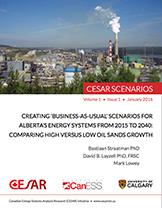Driven by climate change concerns, the world’s energy systems are under pressure to transform and significantly reduce fossil fuel-related greenhouse gas (GHG) emissions. In Canada, this pressure especially affects Alberta, a province that both burns coal to generate electricity and produces and exports natural gas and oil to meet energy demands across Canada and in the United States.
We describe here the assumptions and some high-level results from two different Business-As-Usual (BAU) scenarios for the energy systems of Alberta. BAU scenarios incorporate existing technologies, trends and policies that define demand for fuels and electricity in all parts of the economy. The scenarios are useful in determining the province’s future energy use and greenhouse gas (GHG) emissions if there are no changes in technologies, policies or human behaviour. In effect, BAU scenarios are the benchmark / reference to use in exploring the implications of alternative policy, technology or behavioural changes that will impact energy systems.
Read online
Cite this document
Straatman B, Layzell DB and Lowey M, 2016. Creating ‘Business-as-usual’ scenarios for Alberta’s energy systems from 2015 to 2040: Comparing high vs. low oil sand growth. CESAR Scenarios (January 2016) Volume 1, Issue 1 1-18.

